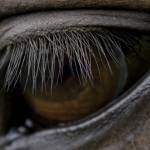How Well Can Horses See in Dim Light?

If you have ever walked out into your pasture at night without a flashlight, you might have gotten the idea that your horses could see you better than you could see them. Or maybe they just heard you walking toward them, or caught your scent, making them aware that you were coming. In any case, by the time you located them, they were already watching you.
To explore equine vision in varying light levels, scientists in Australia conducted two studies. In the first study, they tested the corneas, lenses, and aqueous and vitreous tissues of 24 freshly slaughtered horses to determine how well they filtered ultraviolet light. Results showed that the pattern of UV filtering found in horses is intermediate between what is characteristic for diurnal (active during the day) and nocturnal (active during the night) species. This pattern is common to crepuscular species (those that are active in the low-light periods such as before sunrise and after sunset), indicating that horses have an enhanced ability to use ambient near-ultraviolet light. The human eye is unable to detect light in this range, which means that the horse sees better than humans in dim light. However, horses can’t see in absolute darkness any better than their owners can.
In the second study, researchers compared equine vision in different light intensities by having horses traverse a series of small hurdles in full sunlight, on a cloudy day, on a night with moonlight, and on a cloudy night. Assuming that the horses would jump cleanly if they could see the obstacles well, the researchers recorded the number of times horses hit the cavalletti with their legs in each lighting condition. Results were correlated to light level, horse’s age, sire and dam, and training effect.
Average number of cavalletti strikes showed only minor variation under all lighting conditions. The fewest strikes occurred in darkness and increased sequentially as the horses worked by moonlight, on a cloudy day, and in bright sunlight, a reversed order from what might be expected. It could be inferred that the horses were more careful in dim light and less precise when the task was better lit. A small but significant improvement in performance occurred as the trial progressed, showing an effect of training.
The researchers found a considerable variation in number of strikes per individual horse. When the results were tested against the sire, there was little change, but the effect of the dam was much greater, indicating that visual performance could have a stronger hereditary component related to the maternal parent.








